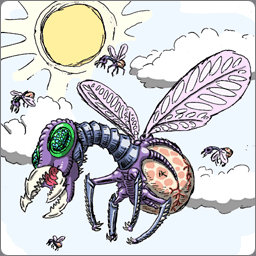
SAIS Galactic Guidebook
Chapter Three: It's Life But Not As We Know It
Darwin said it best when he said "I never met a lifeform I didn't like." Of course, in his later years Darwin also said "This carp is my uncle Antonio." but we won't go into that.
In this continuing chapter of the Galactic Guidebook we examine some of the more interesting creatures which inhabit the myriad planets of Sector Prime. Hang on to your space-o-trons, kids. We're heading back to the galactizoo for more fun facts to know and tell.
 Crab Monster
Crab Monster
Common Name: Crab Monster
Scientific Name: Crustacea Monstrum
Size: Length 3m Height 3m
Diet: Carnivore
Habitat: Tropical beaches and seasonal deserts
Location: Sector Prime temperate and hot planets
Organization: Solitary
Natural Enemies: None
Description: A vicious blue land crab the size of a hovertaxi, it is thickly armored and has two large claws. Above its articulated mandibles, two tiny red
eyes on stalks peer disturbingly in different directions.
Senses: Similar to certain varieties of chameleon, a crab monster can see in two directions at once. Each of its two bubble-like eyes see in a 180 degree arc. Hence, if the creature is active, it is nearly impossible to surprise.
Feeding Habits: A predator and scavenger. A crab monster is as likely to be found ingesting the unwholesome remains of a rotting carcass as stalking another living creature. While scavenging, a crab monster can be fairly docile, unless you get too close. Its elongated pincers are surprisingly agile and razor sharp.
When a crab monster is hunting, no living thing within 50 meters is safe. In melee, it can quickly rotate its shell body 360 degrees while keeping its legs in place. Given its size and the sheer toughness of its chitin armor, attributes like these certainly rate the crab monster as one of the most dangerous, deadly and, well, monstrous creatures known.
Reproduction: Crab monsters reproduce in ways very similar to their smaller aquatic cousins with the exception that maturing eggs are buried. An infant crab monster is very delicate and "cute" but beware. It will likely pinch your finger or toe...off.
Life Span: 125+ years.
 Piranha Bee
Piranha Bee
Common Name: Piranha Bee
Scientific Name: Serrasalmus Hymenoptera
Size: Length 10cm
Diet: Carnivore
Habitat: All habitable regions
Location: Sector Prime temperate planets
Organization: Hive
Natural Enemies: Dragonette
Description: A swarm of these black metallic insects can
stun and devour an entire fuzzy lummox in seven
seconds. Piranha bee honey is a potent aphrodisiac.
Senses: A piranha bee's eyes are multifaceted, and each is set within a gelatinous ovoid of green bioluminescent material. When prey is sighted, and "tasted," its eyes flash brightly alerting other scouts and sentries nearby, all the way back to the hive. The resulting swarm response is immediate.
Feeding Habits: Each massive hive holds fifty or more scouts and over one thousand hunters. Piranha bee scouts are able to search a ten kilometer range for sources of meat. When suitable prey is located, hundreds of hunters swarm to the feeding site.
A piranha bee uses its four rasped mandibles, which exude a potent anaesthetic, to rip its victim's flesh to shreds. The meat is then forced at a rapid rate down its neck and into its bulb-shaped gullet by spring-like metallic bands.
When sated, the piranha bee detaches from its victim and returns to the hive. Its head, legs and wings are removed by worker bees to be reused on a new hunter. The food bulb is then stored in one of the queen's many larders.
Reproduction: Distinguishing a piranha bee queen from the inner structural stalk of the hive itself is difficult, although the large food intake orifice located near the top of the core is easy enough to identify. Essentially, the queen is the hive, and acts as a single mass production mechanism, constantly renewing every element it needs for survival.
At some point the queen will begin to lose vigor. At this stage, queen bulbs (honey bulbs) filled with royal goo are produced. Workers attach legs, wings and special queenly heads, and drive them away to form new colonies. The hive then dies and rapidly decays into a leathery shoe-shaped husk.
Life Span: Up to 10 years.